| Author |
Message |
|
Hadrian Coffin
Industry Professional
Location: Oxford, England Joined: 03 Apr 2008
Posts: 404
|
 Posted: Fri 05 Dec, 2008 6:23 pm Post subject: Seax question Posted: Fri 05 Dec, 2008 6:23 pm Post subject: Seax question |
 |
|
I am making a 19" (13" blade)broken back seax based off of one I photographed in the British Museum. It is not a direct copy more of an inspired by version. The edge is high-carbon 1065 welded to an iron spine and flat ground (no double-bevel). For the grip I plan on using antler crown and securing it with a medieval glue I make of antler shavings. On the spine I am considering inlaying a couple of copper strips. The sheath will be veg. tanned leather with a brass edge.
Now for my question, After heating to an orange heat and plunging into olive oil (to harden the edge) I had a beautiful blue-brown finish on the blade I was about to sand it off as I normally do when I hesitated. The finish is striking and part of me wants to leave it on (i know this has been discussed before but not about seaxes). From what I have seen of originals it is impossible to determine the original colour. I know swords would all be polished and think most seaxes would be as well. However since using original materials I got this very nice result I think medieval smiths could have as well what do you guys think? To be as accurate as possible should I go with a shiny "silver" colour or is the blue-brown colour historical at all?
P.S. this knife is NOT for sale I make knives for myself only.
|
|
   |
 |
G Ezell
Industry Professional

Location: North Alabama Joined: 22 Dec 2003
Posts: 235
|
 Posted: Sat 06 Dec, 2008 12:21 am Post subject: Posted: Sat 06 Dec, 2008 12:21 am Post subject: |
 |
|
I know what you mean, the colors after quenching (and tempering, for that matter) can be beautiful. It doesn't hold up very well if the knife sees any use, rubbing off on whatever the knife is used on. Scale can flake off in a disturbing manner... For that reason, I think it would have been removed before the knife was finished, or quickly removed by use. Unless you have a very nice heat-treating setup, you will likely have a thin de-carbonized skin that will need to be removed after quenching.
With use, especially as a food prep knife, the knife would develop a natural patina that will show off the welded construction, in a subtle manner. Artificial aging with mustard etches can give a knife a few years of patina in short order, if desired.
I love a good sax, I look forward to seeing what you do with it. Good luck with the antler glue, it's a nice authentic touch to use a natural glue for an ancient style knife. Some will tell you antler is not an appropriate handle for a sax, and as far as I know, there are no surviving knives of the period with antler handles remaining... I suspect some of the sax from northern Scandinavia may have had them, at least...
|
|
   |
 |
David Huggins

|
 Posted: Sat 06 Dec, 2008 3:24 am Post subject: Seax question Posted: Sat 06 Dec, 2008 3:24 am Post subject: Seax question |
 |
|
Hi Hadrian,
This blade sounds nice and I look forward to seeing a picture of the finished result. The antler glue sounds interesting, any details?
I guess the grip is a personal preferance, but I would remove the crown of the antler, file off the rough surface and polish the grip with perhaps some incised linear chevron type decoration or a simple ring and dot type decoration, or combination of both. It seems to me these guys had a great liking for decorated objects..even the most mundane of everyday objects.
I have a very small period knife with a simple carved bone grip, the actual knife looks like a pen knife, perhaps used for quill cuting?
best
Dave
and he who stands and sheds blood with us, shall be as a brother.
|
|
   |
 |
Robert P. Wimmers
Industry Professional

Location: Dieren, The Netherlands Joined: 24 Nov 2008
Posts: 44
|
 Posted: Thu 25 Dec, 2008 3:59 am Post subject: Posted: Thu 25 Dec, 2008 3:59 am Post subject: |
 |
|
Salve Omnes!
My very first post on this forum and a question it is ..... I am a beginning hobby blacksmith and have made some Germanis La Tene style ringpommel fighting knives as well as utillity knives before (as well as a good collection of Roman spearheads). Now I have started working on a replica seax.
The handle material eludes me, I have trouble finding a good source of info. Very few handles seem to have been preserved. As no rivetholes are found, so the choice would seem either solid wood or bone/antler. Any info, please??
Then there is the issue of guard and pommelnut. I have seen a lot of pictures (Folkert sent me his fotocollection!) but there seems to be very little evidence for their frequent use, unlike in a lot of seax now being made and offered for sale .. 
Regards,
Robert
|
|
  |
 |
|
Hadrian Coffin
Industry Professional
Location: Oxford, England Joined: 03 Apr 2008
Posts: 404
|
 Posted: Thu 25 Dec, 2008 12:37 pm Post subject: Posted: Thu 25 Dec, 2008 12:37 pm Post subject: |
 |
|
Hi I have loads of pics of originals... The problem with most replicas is they don't look very accurate the hilts were rather plain by modern standards and merchants must make what sells. To many people want them to be all carved and leather covered etc. There are thousands of antique seaxs (I have one in my private collection), during the viking era knives were like a symbol of being a free man and everyone caried them, rich and poor alike, many were made by local smiths and are of dubious quality. The hilt will really depend on the size and type of seax, seaxs range from 3inch little utility knives to lang-saxes the size of a sword. On a few of the quite large ones there are rivets but your statement is very true you don't see rivet holes. Most originals which had a "wittle tang" had simple carved wood hilts, a few of which have survived....
I will post one pic now but I will have many which I can post later.
 Attachment: 47.05 KB Attachment: 47.05 KB
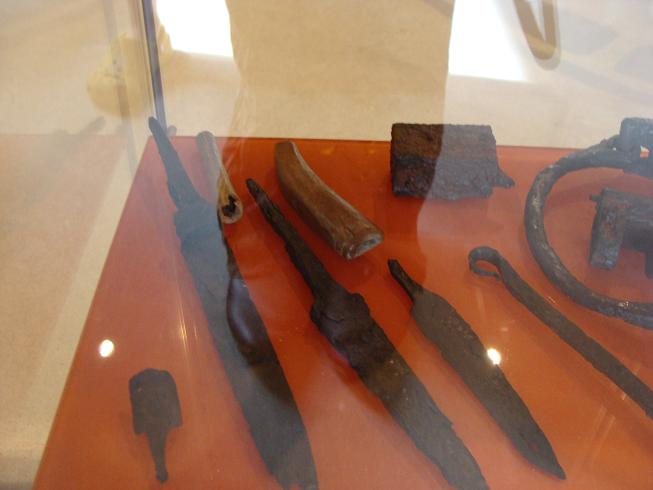
|
|
   |
 |
Robert P. Wimmers
Industry Professional

Location: Dieren, The Netherlands Joined: 24 Nov 2008
Posts: 44
|
 Posted: Thu 25 Dec, 2008 2:38 pm Post subject: Posted: Thu 25 Dec, 2008 2:38 pm Post subject: |
 |
|
Salve Hadrian!
Wow, yes please, most helpful to me (and all true seax fans out there)! You wrote you wanted to use antler on your seax. That was what I was planning, too, as well as some yew core wood. The left handle in the picture you posted also looks to be bone or antler. I would be most pleased if you could post what pictures you have of both bone/antler and wooden handles. You could also send them to my e-mail acount, that has a 10 mb buffer per each mail with a 5 Gb overall limit.
I have made glue using pine ressin mixed with a bit of bonding agent such as charcoal (could use "sacred" yellow ocher as well) and some fat. When heated, it works very well to set things solid. I suppose the bone glue one can buy as pellets and then heat to 100 C should also work very well, that is what I intend to use on the seax. Basicly the same as the glue you made, which is also a bone glue if boiled out of antler scraps. I have used it to set points on my neolithic throwing spears (for an atlatl). I quit chucking flint points, though, (not a very adapt flint knapper, prefer a coal fired forge) but the trials were fun and man, does an atlatl pack a punch!
|
|
  |
 |
G Ezell
Industry Professional

Location: North Alabama Joined: 22 Dec 2003
Posts: 235
|
 Posted: Thu 25 Dec, 2008 6:34 pm Post subject: Posted: Thu 25 Dec, 2008 6:34 pm Post subject: |
 |
|
Hadrian, I too would be most pleased to see any images you have, particularly sax handles, as so few have survived. Can you give us any information on the ones in the image you've posted?
Robert: wood, bone, horn, and ivory seem to have been the more common materials used for grips...whatever was available locally that made a good handle seems to be what was used. The construction is hidden stub-tang, with only adhesive and wedges to hold the knife together in most cases. Metal fittings, judging from the surviving artifacts, were rare in the extreme after 700AD or so, and are generally only found on continental style type I blades, or the full-sized Norwegian single-edged swords. Some surviving grips appear to have traces of wire wraps.
|
|
   |
 |
Bruno Giordan

|
 Posted: Fri 26 Dec, 2008 12:33 am Post subject: Re: Seax question Posted: Fri 26 Dec, 2008 12:33 am Post subject: Re: Seax question |
 |
|
| Hadrian Coffin wrote: | I am making a 19" (13" blade)broken back seax based off of one I photographed in the British Museum. It is not a direct copy more of an inspired by version. The edge is high-carbon 1065 welded to an iron spine and flat ground (no double-bevel). For the grip I plan on using antler crown and securing it with a medieval glue I make of antler shavings. On the spine I am considering inlaying a couple of copper strips. The sheath will be veg. tanned leather with a brass edge.
Now for my question, After heating to an orange heat and plunging into olive oil (to harden the edge) I had a beautiful blue-brown finish on the blade I was about to sand it off as I normally do when I hesitated. The finish is striking and part of me wants to leave it on (i know this has been discussed before but not about seaxes). From what I have seen of originals it is impossible to determine the original colour. I know swords would all be polished and think most seaxes would be as well. However since using original materials I got this very nice result I think medieval smiths could have as well what do you guys think? To be as accurate as possible should I go with a shiny "silver" colour or is the blue-brown colour historical at all?
P.S. this knife is NOT for sale I make knives for myself only. |
As far as I know the only seax not found in rusted condition is that of Charlemagne, and it is just pattern-welded.
The italian examples are invariably found heavily rusted so I cannot help you.
I had in my hands one for quite awhile (legally examining it in a museum) I performed the traditional "cling test" with a little round metal object, to me and the other examiner it sounded like plain iron, unhardenable.
Unscientific as it is, its the only possible test here, as it would be impossible to slice an original for metallographic analysis.
|
|
  |
 |
|
Hadrian Coffin
Industry Professional
Location: Oxford, England Joined: 03 Apr 2008
Posts: 404
|
 Posted: Sat 27 Dec, 2008 9:14 pm Post subject: Posted: Sat 27 Dec, 2008 9:14 pm Post subject: |
 |
|
Hi here are some more pictures as promised. On the previous one the left hand one is bone the one on the right is carved wood in a shape reminiscent of antler tine (tip) the right hand one is interesting as the tang slot is drilled through the curve with an opening at each end, the knife the hilt belonged to curved with the handle and was peened at the end.
Another interesting way I secure knife handles to wittle tangs is to melt pewter and pour it into the slot in the handle when it hardnes it creates an amazingly powerful bond, the historic evidence for this is scarce there are several knives and seaxes with globs of what looks like melted metal corroded onto the tang. It is not necisarilly historical but it is certianly historially plausible. another benefit of the metal glue is that it ads weight and balance nicely to the hilt.
| Quote: | As far as I know the only seax not found in rusted condition is that of Charlemagne, and it is just pattern-welded.
The italian examples are invariably found heavily rusted so I cannot help you.
I had in my hands one for quite awhile (legally examining it in a museum) I performed the traditional "cling test" with a little round metal object, to me and the other examiner it sounded like plain iron, unhardenable.
|
I have several original seaxes in my collection with blades of plain iron. I have made several re-creations of my originals out of untempered Iron and it is surprising how well they perform. You don't need all that fancy tempering to get a very nice blade, the edge wears out sooner but it is very easy to re-sharpen. You see all thoughs originals worn down to nubs from repeated sharpening, most say that it was from years of use, but I sometimes wonder if its because the blades where poorly tempered and needed more frequent sharpening.
All the swords and spears that have been preserved in a pristine state are "silver" in colour from fine polishing
any way here are the pics...
 Attachment: 51.94 KB Attachment: 51.94 KB
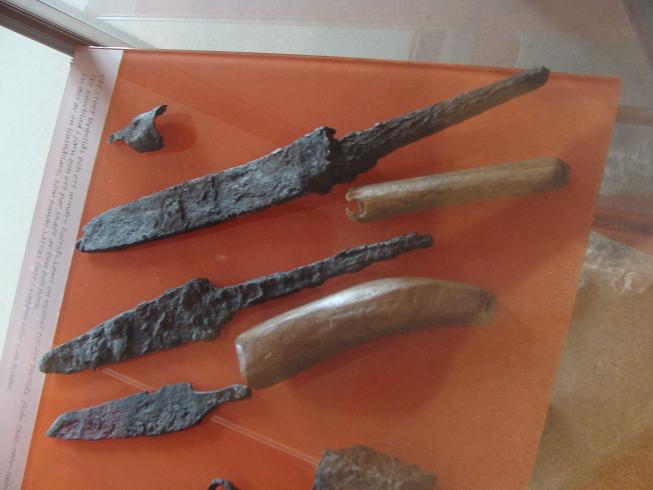
 Attachment: 56.96 KB Attachment: 56.96 KB
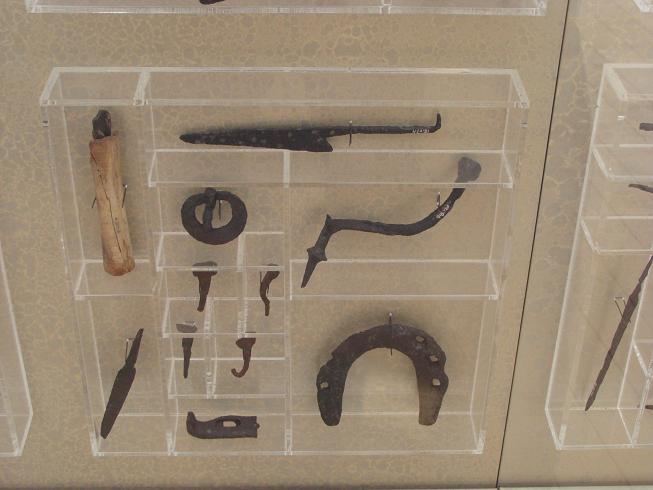
hilt of bone
 Attachment: 61.53 KB Attachment: 61.53 KB
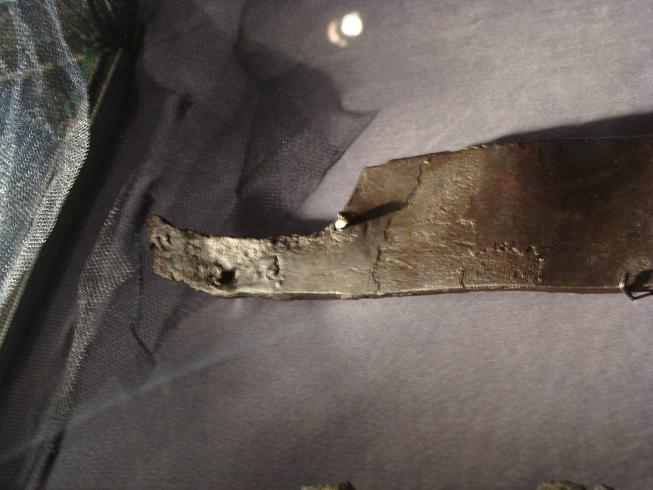
tang of langsax with rivet remmanants
 Attachment: 51.25 KB Attachment: 51.25 KB
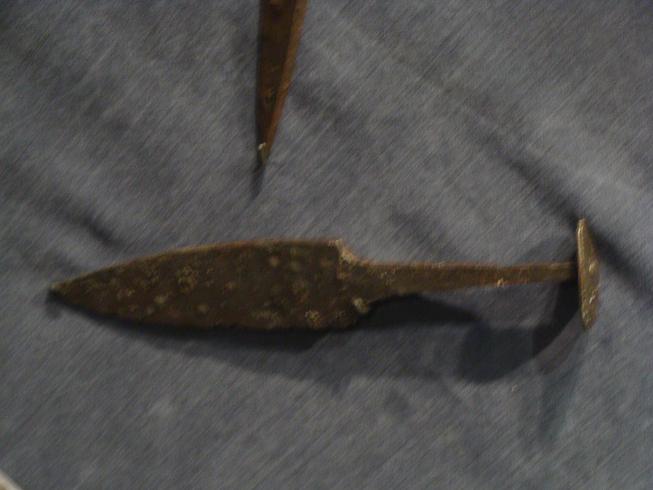
bizzare 9th cent. knife dubbed a seax with a rondel on the tang!!!!
 Attachment: 55.82 KB Attachment: 55.82 KB
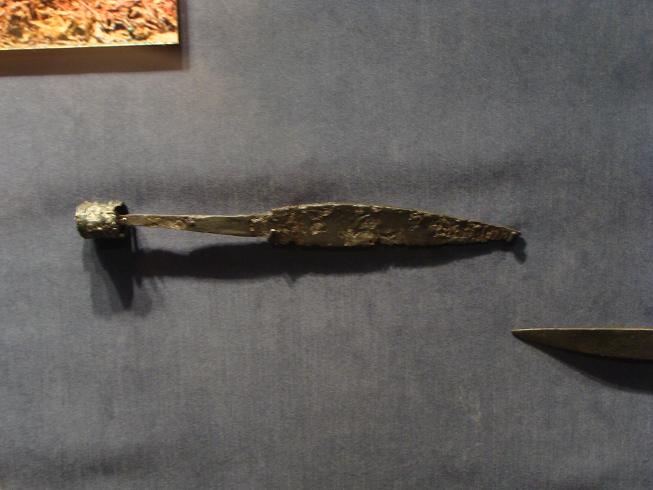
odd pommeled seax
|
|
   |
 |
|
Hadrian Coffin
Industry Professional
Location: Oxford, England Joined: 03 Apr 2008
Posts: 404
|
 Posted: Sat 27 Dec, 2008 9:40 pm Post subject: Posted: Sat 27 Dec, 2008 9:40 pm Post subject: |
 |
|
More pics I was running out of room on my last post... I can post more veiws on request
 Attachment: 60.18 KB Attachment: 60.18 KB
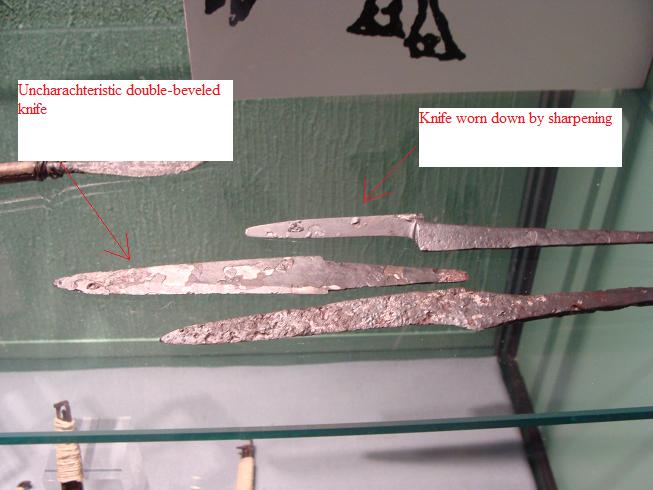
 Attachment: 47.96 KB Attachment: 47.96 KB
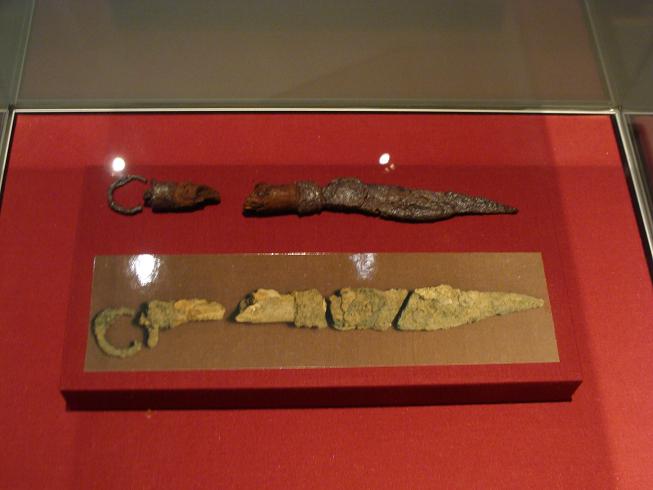
ring-hilt wood hilt seax
 Attachment: 42.77 KB Attachment: 42.77 KB
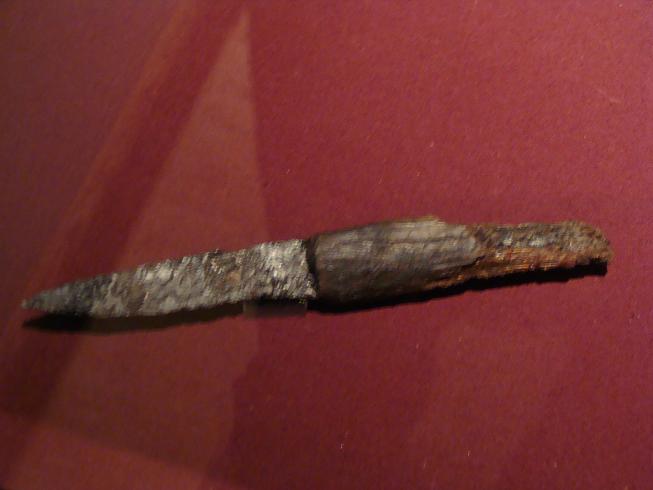
seax wood hilt
 Attachment: 42.11 KB Attachment: 42.11 KB
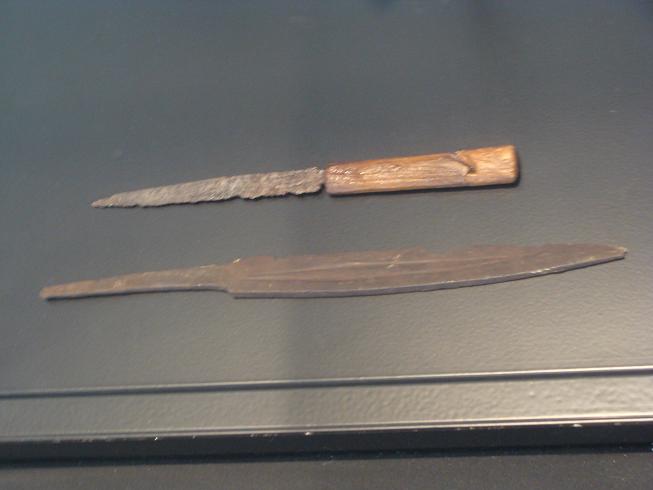
hit of wood
 Attachment: 54.83 KB Attachment: 54.83 KB
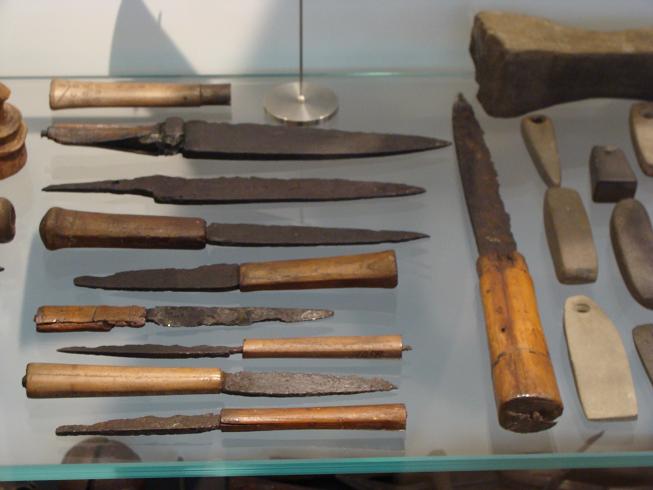
lots of viking seaxes all with wood hilts
 Attachment: 43.47 KB Attachment: 43.47 KB
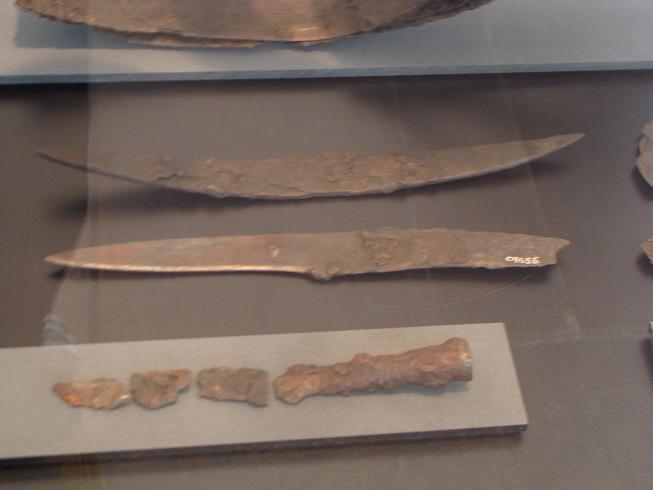
a group of very weird supposedly viking era knives
|
|
   |
 |
|
Eric Myers
Location: Sacramento, CA Joined: 23 Aug 2003
Posts: 214
|
|
  |
 |
Robert P. Wimmers
Industry Professional

Location: Dieren, The Netherlands Joined: 24 Nov 2008
Posts: 44
|
 Posted: Sun 28 Dec, 2008 2:09 pm Post subject: Posted: Sun 28 Dec, 2008 2:09 pm Post subject: |
 |
|
These pictures are wonderfull!! To show my gratitude, I drove to the new Xanten museum in Germany to add a few pictures to the collection:
As an afterthought, the seax in the picture is about 58 cm with a 18 cm wooden handle. What remains of the sheath looks to have been wood as well, perhaps an inner wooden core. The blade is decorated with grooves and small punched circles, but this can't be seen in the picture now due to loss of quality compressing it. These are finds from 1 grave, there is also a small utilityknife with a wooden handle hanging from the belt to the right.
 Attachment: 41.23 KB Attachment: 41.23 KB
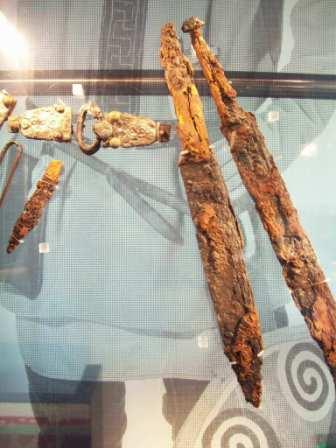
 Attachment: 48.13 KB Attachment: 48.13 KB
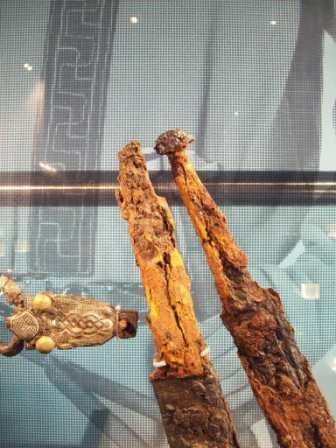
Last edited by Robert P. Wimmers on Mon 29 Dec, 2008 2:48 am; edited 1 time in total
|
|
  |
 |
|
Jeroen Zuiderwijk
Industry Professional
|
 Posted: Mon 29 Dec, 2008 2:43 am Post subject: Posted: Mon 29 Dec, 2008 2:43 am Post subject: |
 |
|
| Hadrian Coffin wrote: | | Hi here are some more pictures as promised. |
Hi Hadrian. Unfortunately most of these are either Roman or iron age, and therefore not saxes (at least by modern archeology). There's actually quite a lot of examples of saxes with hilts preserved. Particular the better preserved examples from graves frequently have remains of the hilt attached. Unfortunately though, it's generally just bits that are closest to the tang that have been preserved, with the outer part of the hilt decayed away. So from that, and the size of the tang it gives an indication of the minimum measurements of the hilt, but not the actual shape and decoration. However, there is evidence that shows more. However, you have to restrict yourself to specific types of saxes, as the hilt evolved along with the blade. Early narrow saxes f.e., seem to have had fairly short hilts (by sax standards). A well preserved example can be seen below:

These saxes are from Krefeld-Gellep, Germany and date to around 5th-6th century (estimated).
Later narrow saxes, and the following light broad saxes frequently have metal components in the hilts. The hilts also grow longer, with grips of around 15cm.

Army Museum, Delft, Netherlands (provenance not given). Braided bands or snakes engraved in the blade.

Sax from Nijmegen, Netherlands, 500-600AD. Braided bands or snakes engraved in the blade.

Reconstruction of a light broad sax by Jaap Ypey (was the expert on early medieval weaponary in the Netherlands) from Rhenen, Netherlands next to a reconstruction and original scabbard from the depot in Groningen, Netherlands (exact provenace unknown). The grip is wood, with a leather cover. Jaap mentions a sax with leather covered grip been found, but I still have to track down the reference.
And a later light broad sax, which already doesn't have the metal hilt components anymore like the later heavy broad saxes:

It's from Meerssen-Rothem, Netherlands. The grip is probably horn. The sax is pretty small for a broad sax, the blade roughly 25cm.
Then we get to the broadsaxes. Here virtually all saxes have no metal components anymore. These saxes nearly all have blind tangs glued into simple wooden or horn hilts. There are a few rare examples where a rivet was used to fix the blade, and I've come across a single example with a full tang hilt which originally had grip scales. This one however gives the best evidence for the shape of the hilt:

This heavy broad sax is from Weingarten, Germany, dating to 610-660AD. The size is 569mm. So if you take the outline of the tang, and the size of the rivets, this gives a pretty good reconstruction of the shape of the original hilt, which was shaped much like the lower half of the haft of a modern hammer. Note that the hilt is 225mm long, 49mm at the widest and 27mm at the thickest.
That's not unusual for broad saxes. Just exactly how large these hilts could get is well illustrated by this example:

It's from the Württembergische Landesmuseum, Stuttgart, Germany and dates to 7th-8th century. Mind that that's a blind tang, so the actual hilt would be even longer.
The best preserved hilt that I know on a broadsax is this example:


It's from the Umler Museum, Ulm, Germany and dates to the 7nd century. It shows the outside of part of the hilt, which seems to have a leather cover from the looks of it.
continued in next post
Last edited by Jeroen Zuiderwijk on Mon 29 Dec, 2008 2:57 am; edited 1 time in total
|
|
   |
 |
|
Jeroen Zuiderwijk
Industry Professional
|
 Posted: Mon 29 Dec, 2008 2:44 am Post subject: Posted: Mon 29 Dec, 2008 2:44 am Post subject: |
 |
|
continued from previous post
Then we get to lang saxes. Of these I don't have as good examples as for broad saxes. But generally the tangs seem to be identical in shape and size and some of the wood remains around the tangs seem to indicate a similar shape and size hilt. The example with most of the hilt preserved that I know is shown below:

This example is from Leusden, Netherlands, 8th century. The total length is 772mm.
Then there's the broken back saxes, of which we're very lucky to have the hunting knife of Charlemagne:

The total length is 53cm, and the hilt 23cm. The hilt is horn with a silver (?) ferrule. The ferrule is not seen with any other broken back saxes, and may be a later addition.
There's also two images of broken back saxes in the Stuttgart Psalter from 820-830AD:

Well, that's it from saxes of north-west Europe. I've got a lot more material, but they all show mostly the same. Wherever there's grip material left, it's either wood or horn.
|
|
   |
 |
Robert P. Wimmers
Industry Professional

Location: Dieren, The Netherlands Joined: 24 Nov 2008
Posts: 44
|
 Posted: Mon 29 Dec, 2008 4:22 am Post subject: Posted: Mon 29 Dec, 2008 4:22 am Post subject: |
 |
|
Hi All!
Thanks Jeroen, for the instructive post. If you PM me a regular e-mail adress, I will send you the Xanten pictures to be added to your German database. That sax is given as 7 th century. I am still a bit fuzzy on the actual sizes of sax. There is a nice typology on your "information about saxes" but I missed the scalebar.
I am adding a picture of a 7th cent sax in Xanten. At 35 cm overall, this would class as a light droppoint broadsax of around 630 AD (typology)?? And these would typicly not have metal fittings to the hilt? With a 25 to 50 centimeter blade?
Broken back saxes are not shown in the typology, are these only found in Britain?
This a most instructive thread, by the way! Thanks all!!!
 Attachment: 24.45 KB Attachment: 24.45 KB
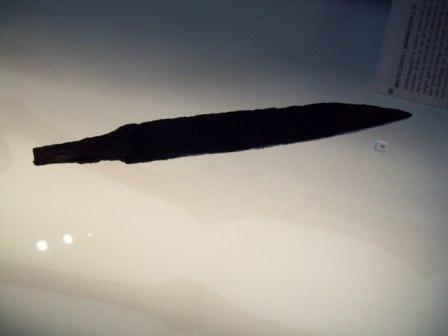
|
|
  |
 |
|
Hadrian Coffin
Industry Professional
Location: Oxford, England Joined: 03 Apr 2008
Posts: 404
|
 Posted: Mon 29 Dec, 2008 8:27 am Post subject: Posted: Mon 29 Dec, 2008 8:27 am Post subject: |
 |
|
Here is another not the greatest quality but the light was bad
 Attachment: 76.26 KB Attachment: 76.26 KB
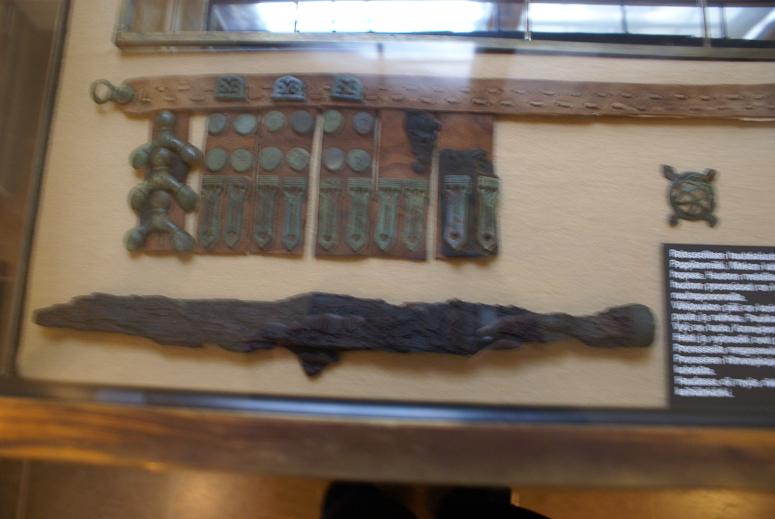
hilt of wood wth metal front and end caps
|
|
   |
 |
|
Hadrian Coffin
Industry Professional
Location: Oxford, England Joined: 03 Apr 2008
Posts: 404
|
 Posted: Mon 29 Dec, 2008 8:30 am Post subject: Posted: Mon 29 Dec, 2008 8:30 am Post subject: |
 |
|
One more c.9th cent.
 Attachment: 63.56 KB Attachment: 63.56 KB
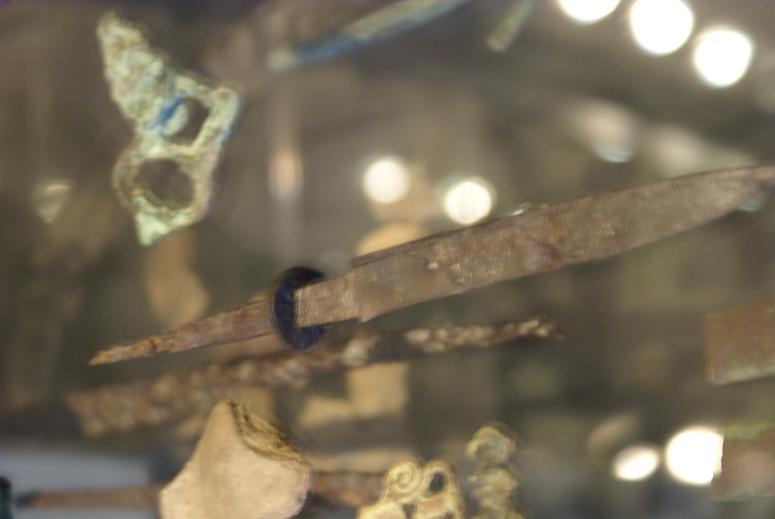
|
|
   |
 |
Bruno Giordan

|
 Posted: Mon 29 Dec, 2008 11:45 am Post subject: Posted: Mon 29 Dec, 2008 11:45 am Post subject: |
 |
|
| Hadrian Coffin wrote: | | More pics I was running out of room on my last post... I can post more veiws on request |
THANK YOU
|
|
  |
 |
|
Jeroen Zuiderwijk
Industry Professional
|
 Posted: Mon 29 Dec, 2008 3:48 pm Post subject: Posted: Mon 29 Dec, 2008 3:48 pm Post subject: |
 |
|
| Robert P. Wimmers wrote: | Hi All!
Thanks Jeroen, for the instructive post. If you PM me a regular e-mail adress, I will send you the Xanten pictures to be added to your German database. That sax is given as 7 th century. I am still a bit fuzzy on the actual sizes of sax. There is a nice typology on your "information about saxes" but I missed the scalebar. |
There's quite a bit of variation on size. Broad saxes can vary from 25 to 50 cm blade length, and 3 to 6 cm blade width, and the thickness anywhere between 4 and 10 mm.
Generally the earlier ones are smaller, the later ones larger, but there is some overlap. Langsaxes in the Netherlands have a pretty narrow size range, with the blade generally around 50-60 cm long, 40 to 48 mm wide and 5 to 9 mm thick. Other countries have longer examples as well though.
| Quote: | | I am adding a picture of a 7th cent sax in Xanten. At 35 cm overall, this would class as a light droppoint broadsax of around 630 AD (typology)?? |
That should be about right.
| Quote: | | And these would typicly not have metal fittings to the hilt? With a 25 to 50 centimeter blade? |
Some early light broadsaxes do have either a metal bolster or bolster and pommel. But the majority don't have them. With heavy broadsaxes there are virtually no examples with metal hilt parts.
| Quote: | | Broken back saxes are not shown in the typology, are these only found in Britain? |
No, they're also found at least in the Netherlands and Germany, though not quite as common as in the UK. With broken back saxes you have to keep in mind that there are basically two different broken back saxes, the long sax variant with parallel edges (Hurbuck type), similar to the curved back longsaxes but with a sharp angled back, and the smaller broken back saxes, which have the back and edge expanding from the hilt (Honey Lane type).
|
|
   |
 |
Robert P. Wimmers
Industry Professional

Location: Dieren, The Netherlands Joined: 24 Nov 2008
Posts: 44
|
 Posted: Tue 30 Dec, 2008 1:51 am Post subject: Posted: Tue 30 Dec, 2008 1:51 am Post subject: |
 |
|
| Jeroen Zuiderwijk wrote: | | No, they're also found at least in the Netherlands and Germany, though not quite as common as in the UK. With broken back saxes you have to keep in mind that there are basically two different broken back saxes, the long sax variant with parallel edges (Hurbuck type), similar to the curved back longsaxes but with a sharp angled back, and the smaller broken back saxes, which have the back and edge expanding from the hilt (Honey Lane type). |
Ha, so would that imply that all those "short" (13 inch) broken back replica's with paralell sides are basicly not historicly correct ??
I wonder how early saxmakers got a mirror polish on their blades. I am making some seax presently, using old tool steel, forge and files. I suppose using stones? to plane down the small grooves the files leave was an option.
|
|
  |
 |
|
|
You cannot post new topics in this forum
You cannot reply to topics in this forum
You cannot edit your posts in this forum
You cannot delete your posts in this forum
You cannot vote in polls in this forum
You cannot attach files in this forum
You can download files in this forum
|
All contents © Copyright 2003-2025 myArmoury.com — All rights reserved
Discussion forums powered by phpBB © The phpBB Group
Switch to the Basic Low-bandwidth Version of the forum
|

